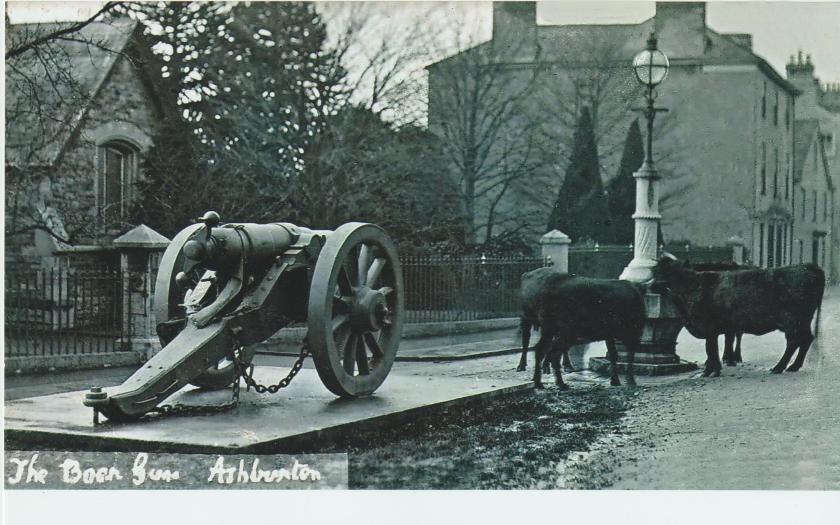
'FOUND. Left at my market on Ashburton Fair, June 6th, 1 light coloured Store Heifer. Owner please communicate with J A Sawdye, Ashburton'
Western Morning News 29 June 1935 p2 col4
Early history
1310 (see below) is the usual date given for the origin of a market at Ashburton. However, in his Presidential Address to the Devonshire Association, J S Amery says that in the Cartulary of Buckfast Abbey there is a grant from Roger de Nunant for the safety of his soul and that of his wife Alice. The wording is: 'Libertate, tamen, retenta eundi et redeundi michi et hominibus meis per uiam de Norbroc ad niewfort , ad forum de Aspernetune - To myself and my men, however, I retain free right of way from the North Brook road to the New Ford, on our way to Ashburton market' .*
Report and Transactions of the Devonshire Assocation, vol 56, Plymouth 1925, p48
*Translation is from History of St Mary's Abbey of Buckfast (in the County of Devon), 760-1906, Dom Adam Hamilton, 1906, p40Dr
Samantha Letters, in the Gazetteer of Markets and Fairs in England and
Wales to 1516, says that the reference is to a charter of Henry de
Nunant, and to an earlier one of his father Roger. She dates it to
before 1176-77, when Roger de Nunant died.
http://www.history.ac.uk/cmh/gaz/gazweb2.html - Accessed 9-05-2016
1310 (the third year of the reign of Edward ll)
'King Edward II granted a market at Asperton on Saturdays, to Walter Stapleton, Bishop of Exeter, and a fair for three days at the festival of St. Lawrence.'
Ref given as Rot. Cart. 3 Edward 11.21 in Magna Britannia, vol6 part 2, Lysons 1822, p12
Rot. Cart is Rotuli Chartarum, or Charter Rolls. In the National Archives?
*******
J S Amery quotes from a legal action in 1630 between, amongst others, Thos. Prideaux and Thos. Ford.* Nicholas ffabyan of Ashburton, tanner, 'confirmed that the Pillory, Cage or Prison house of the Boro did stand within the said Market House and that the Stocks for the said Boro sometimes stood within the said market house and sometimes in the said market-place.'
Mr Amery
gives a reference of 6th Charles I (1630), and says the action was in
the Exchequer. This might be E 134/6Chas1/Mich2, which concerns the mortgage of 'The toll and other things within the manor of Ashberton (Devon)' The participants were Thomas Prideaux senior and junior, Thomas Harris and Richard Harris, versus Sir John Brune, Knt, Thomas Ford senior and junior and William Abarrow.
Report and Transactions of the Devonshire Assocation, vol 56, Plymouth 1925, p72
It seems likely to be linked to the document from the
following year in the National Archives, 'Accounts of the profits of the
market, Prideaux and Harris v. Ford and Others.' At least part of the dispute concerned the weighing of wool and yarn.
A 'common beam', a device for weighing commodities such as wool, was often housed within market halls. It was a legal requirement to use this official measure, and its importance was such that tolls could be levied on its use. Goods could be forfeited if alternative beams were used.
Two rival beams were set up in Ashburton, one by Thomas Prideaux and one by William Abarrow, who both claimed the profits. Thomas Prideaux 'did walk up and down the said market...with a sword by his side, and did threaten the said William Abarrow,' claiming that his father would spend a thousand pounds to ensure that he could retain the profits. He unhung the weights belonging to William Abarrow, threatened the market people if they did not use his own beam, and overturned stalls. He '[did] terrify them much.'
http://discovery.nationalarchives.gov.uk, 7 Charles I ref E 178/5236, quoted in The Agrarian History of England and Wales vol 4:1500-1640, Ed. Joan Thirsk, Cambridge 1967 p483
*******
Ashburton and Its Neighbourhood, Charles Worthy, Ashburton, 1875, p7
In the 22nd year of Charles II's reign a case was brought by a person called Yard against Ford. Yard claimed that Ford had 'without any lawful warrant or authority' set up a Tuesday market at Ashburton selling yarn and other merchandise, which was affecting his own Wednesday market at Newton Abbot. The plaintiff won the case, and was awarded £60 damages.
The Reports of Sir Edmund Saunders of Several Pleadings and Cases in the Courts of the King's Bench, vol 2, part 2, London 1845, p171
The Charity Commissioners stated that in the same year Charles II granted to John Ford 'by letters patent...a market, to be held weekly on every Tuesday... and also within the said market all the tolls, profits, advantages and emoluments whatsoever to the said market...'
In his will he left an annuity of £8 to be paid out of the market's profits to pay for poor children to learn to read the Bible.
The Report of the Commissioners Concerning Charities, Devon, vol 1, Exeter 1826, p146
*******
Andrew Quick, first elected member for the borough in 1712, procured for it two...fairs, on the first Tuesday in March and the first Thursday in June, and these fairs are still held upon those days.
Ashburton and its neighbourhood, Charles Worthy,printed and publ L B Varder, Ashburton 1875, p7
*******
Journal of a Tour around the Southern Coasts of England, John Henry Manners, 5th Duke of Rutland, London, 1805, p101ff
In 1842 Lurgecombe grist and flour mill was sold by Mr John Pearce, a selling point being that an 'excellent' corn market was held in Ashburton.
Western Times 5 March 1842 p1 col2
*******
In November 1845 the Western Times reported that potatoes were still in short supply. They were selling at 1s for 20lb at the weekly fair, double the price of the same week the previous year. Flour was 2s 4d for 12lb, compared to 1s 8d the previous year. Labourers' wages were unchanged - the newspaper demanded that 'things must change, and that soon'.
Western Times 29 November 1845 p5 col1
Potato blight was rife in the summer of 1845 - notably the cause of the Irish famine
http://www.digitalhistory.uh.edu
*******
1848. James Foster, described as an elderly fish-dealer, was summoned for selling fish from a stall in East Street. Robert Bowden, one of the Surveyors of the Highways, had told him to stop the practice after complaints, but Foster ignored his warnings. The defendant said that he had sold fish there for 41 years.
Mr
S Mann, the 'market man', stated that the fish market had been near the
Shambles since 'time immemorial'. He believed it had been the market
place for 300 years.
During
the course of the case it was stated that the sheep and bullock market
had also been held in the streets for as long as anyone could remember.
The magistrates imposed costs of 14s 6d, and because these were heavy the fine was only 1s.
Wheat 6s 6d to 7s
Barley 4s to 4s 3d
Oats 2s 4½d per bushel
Shambles:
Beef 5½d to 6½d
Mutton 6d to 7d
Pork 5½d to 6½d
Veal 6½d per lb
Geese 7d per lb
Ducks 4s
Fowls 3s a pair
Potatoes 1s per 20lb
Butter 11d per lb
Eggs 11d a dozen
Yolk wool 5d per lb*.
4lb loaf 6d to 6½d
Flour 2s per 12lb
Exeter Flying Post 9 November 1848 p8 col3
* See The Mills section for more on yolk wool.
The Archaeological Journal, vol 3, London, 1846, p266
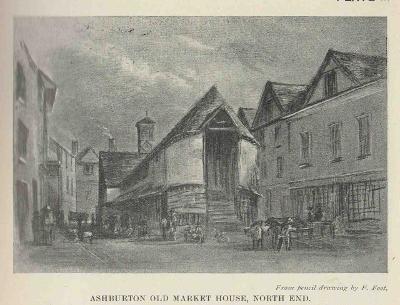
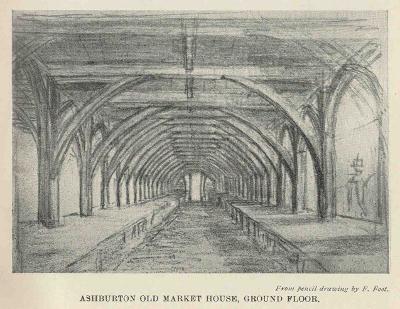
Report and Transactions of the Devonshire Association, Plymouth 1925, opp. p100
For more on Frederick Foot, see Musicians, Poets and Artists, under Famous Ashburtonians
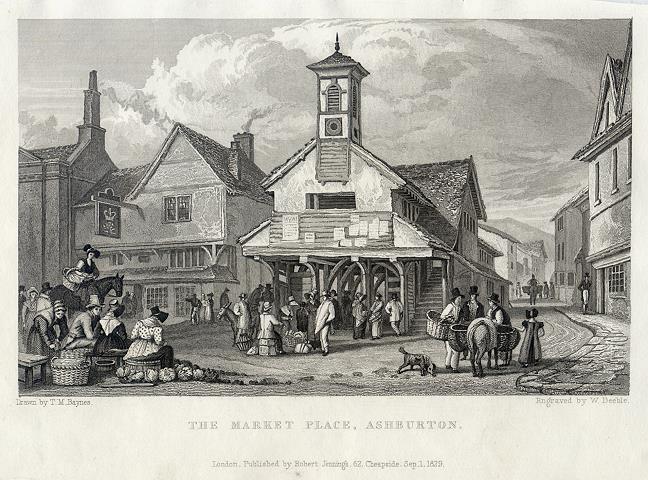
Left: The old Market Place, 1830s. Engraved by William Deeble after a picture by D M Haynes, and published in History of Devonshire, 1830.
Many thanks to http://www.ancestryimages.com
In 1849 a petition (called a 'memorial') was sent to Lord Clinton concerning the dangerous state of the market hall, presumed to be the oldest in the county. As the receiver of all the tolls of the market and fairs, the petitioners hoped that Lord Clinton would build a new market hall: one of their concerns was to have a place for the sale of fish, rather than have it sold in the open street as at present.
Exeter and Plymouth Gazette 28 July 1849 p8 col4
A new market hall, now called the Town Hall, was built by Lord Clinton in 1850.
When
the old shambles was demolished the materials were auctioned off. They
included several elm trees and some fine old English oak, said to be
over 500 years old.
During the removal 'no coins of much antiquity' had been found.
Western Times 9 November 1850 p1 col2
Exeter Flying Post 21 November 1850 p8 col2
Right: The new Market Hall, from an old print
From my own collection
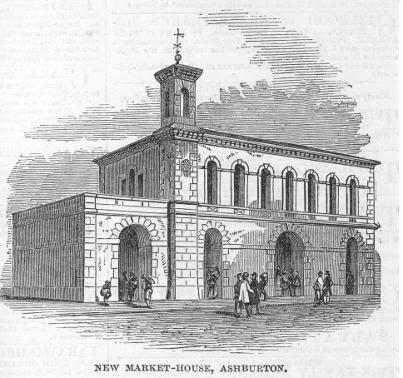
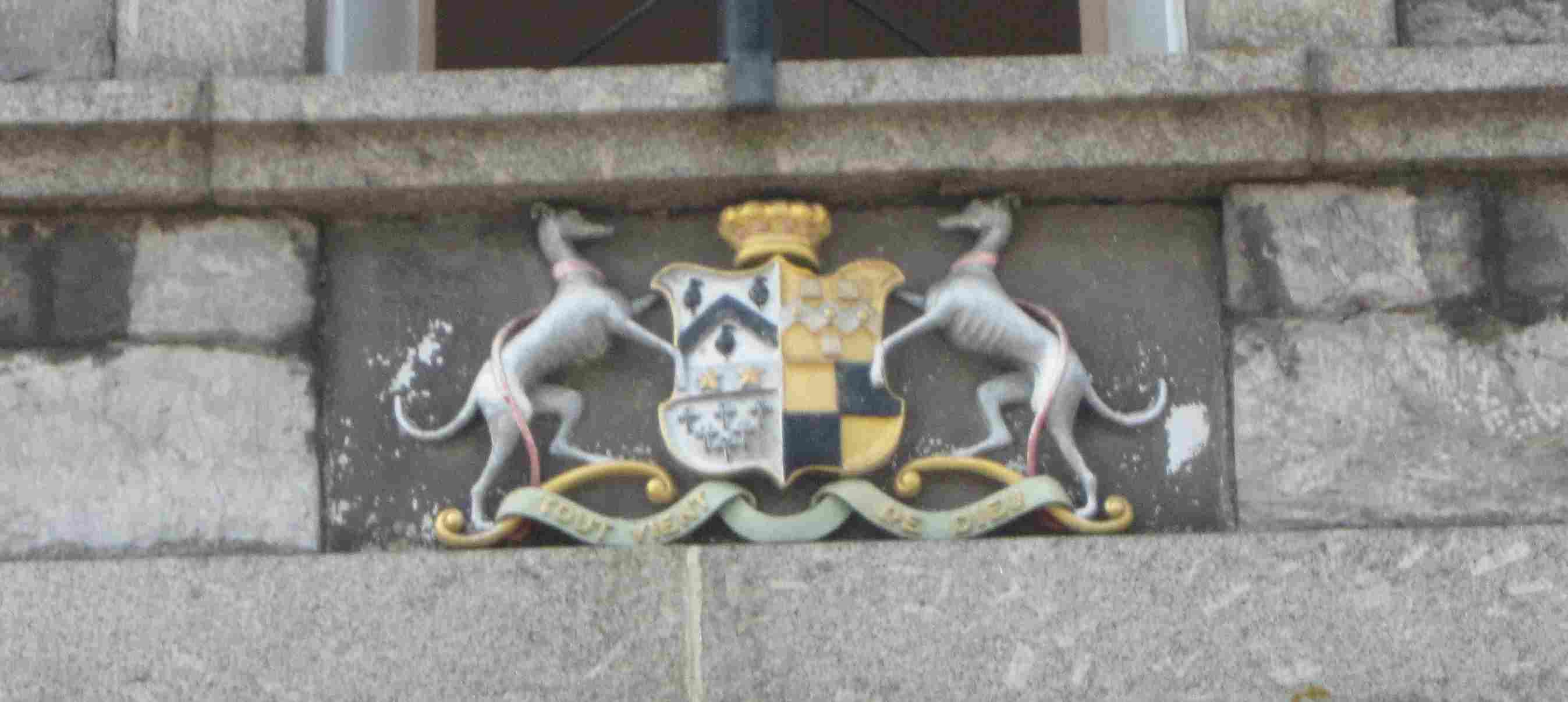
Left: The Arms of Lord Clinton on the Town Hall
My own photograph 2013
Mr John Tickell, of Ilsington, had the contract for supplying the granite.
Exeter Flying Post 31 January 1850 p8 col4
The three clock dials from the old market house were overhauled by Mr J Horson, and refitted in the tower of St Lawrence Chapel.
Exeter and Plymouth Gazette 14 June 1851 p4 col1
Not everyone was happy with the new Town Hall. A correspondent to the Exeter and Plymouth Gazette in 1851 accused the new lessee of the market of enforcing arbitrary rules and tolls. No-one, it was alleged, was allowed to carry anything through the street, or display anything in a window, without paying such tolls.
Exeter and Plymouth Gazette 25 October 1851 p4 col3
The March fair has a large supply of cattle, and the November fair is a great sheep mart.
White's History, Gazetteer and Directory of Devon 1850 p462
*******
In June 1851 Cecil Torr's grandfather wrote to his
father 'People say that Ashburton Fair is past, and the apples are safe'
In other words, Torr explains, the danger of frost was over by the
first Thursday in June.
Small Talk at Wreyland, Cecil Torr, Cambridge University Press 1918, Adams and Dart edition 1970, part 1 p 41
*******
The market, an excellent one, is held on Saturday; and
the fairs on the first Thursdays in March and June, the 10th of August
and the 11th of November.
Slater's Directory of Berks, Cornwall and Devonshire, 1852-53, p5
*******
There
was panic in the autumn of 1854, as the price of corn rose steeply.
Millers and bakers had low stocks, as they thought demand would slow
after the harvest. Anybody holding corn was reluctant to sell.
Western Times 28 October 1854 p5 col4
*******
Exeter and Plymouth Gazette, 22 September 1871, p6 col7 ff
*******
The Market Hall, with the pannier, fish and corn market, was put up for sale in 1915. This came with the Lordship of the Manor. The bidding started at £500, and Mr H M Firth of the Knowle finally bought it for £1400.
Western Times 12 March 1915, p3 col3
See the 1920s area of the Virtual Museum for sale particulars of the Town Hall in 1927
*******
Western Times 30 June 1881, p3 col5
*Bilberry
*******
John Satterly, Memories of Ashburton in Late Victorian Days, Transactions of the Devonshire Association, vol 84, 1952, p32
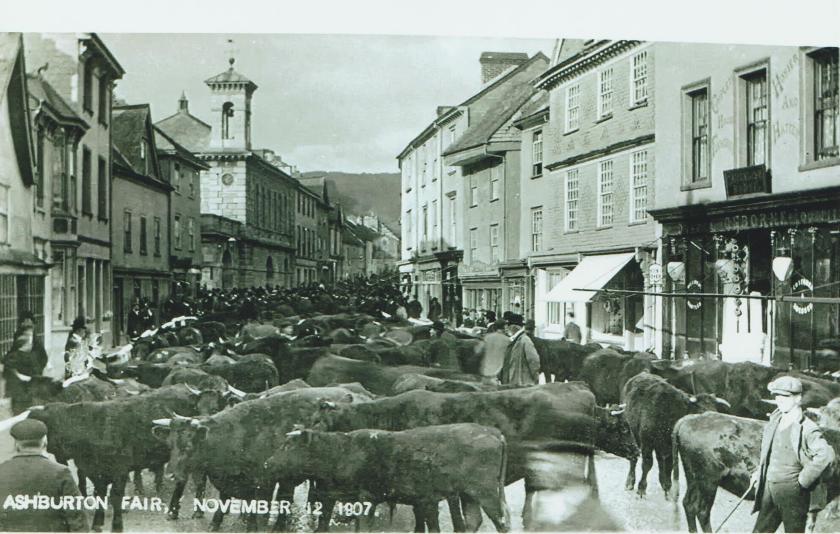
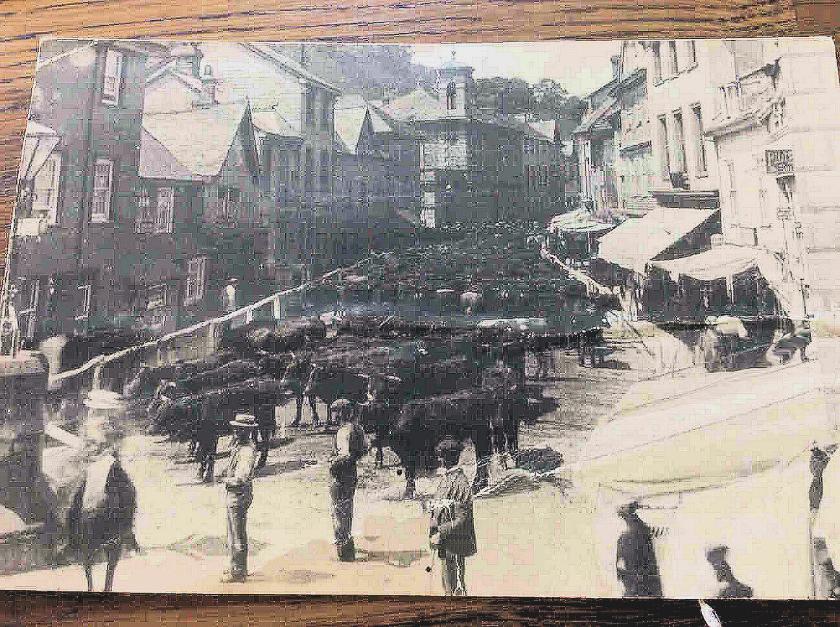
'Cattle market day came monthly, on the third Saturday. The Friday evening before the custodian of the Market Hall - a Mr Coleman - fenced in the bottom of North Street. At every five yards in the curb of the pavement there were square iron holes about nine inches deep. Short iron uprights 4ft high were placed in these. Spikes at the top supported horizontally the long wooden "two by fours" comprising the fence. Thus the street became a fenced compound for the cattle and the pavements were left free for pedestrians.'
'On market days North Street was left in a terrible mess from the animals, and after the advent of the Bowdley water supply the street was hosed and the mess sent down into the sewers.'
Prof John Satterley, Ashburton in Late Victorian Days, Transactions of the Devonshire Association, vol 84, Torquay 1952, pp 32, 26
The May 1872 cattle market was the first being held with the benefit of the new railway line.
Western Times 10 May 1872 p7 col2
In 1906 a special train was laid on to bring dealers to the March fair.
The Exeter and Plymouth Gazette 2 March 1906 p12 col5
From the memories of Reg Andrews, born 1893.
With thanks to Dave Hodge-Brooks and Ernie Smerdon.
Prof John Satterley, Ashburton in Late Victorian Days, Transactions of the Devonshire Association, vol 84, Torquay 1952, p 33
1907 It was proposed that a cattle market was built in Ladwell Orchard. There was some discussion at a meeting of the Urban District Council as to who should bear the costs of covering the stream that flowed through it.
At the same
meeting Mr J Fogden, hairdresser, had sent a 'very long letter' to the
Urban District Council, enclosing a bill for taking preventative
measures to stop cattle breaking his windows at a recent fair. The
Council denied liability.
Western Times 13 September 1907 p6 col6
Western Times 12 November 1910, p3 col3
The Cattle Market in the 1920s
Cattle markets were held frequently, the animals brought in by drovers or farm labourers. The bleating of the sheep and the shouting of the men created havoc in the streets. Manure was often deposited in the street by the animals and keen gardeners would appear with a bucket and shovel to remove the deposit for enriching their soil - many people grew vegetables in their gardens, and took great pride in the size and quality of their produce.
Public houses were open all day when the markets were held, but some men were TT*. The back of Mrs Mann's shop was partitioned off for farmers to use on Fair Days when they ate their pasties and drank tea. They sat on wooden forms having their meal and discussing the state of the economy as it affected them. This little enclosure with its bare table and forms provided a peaceful retreat from the noise of the animals and the shouts of the drovers.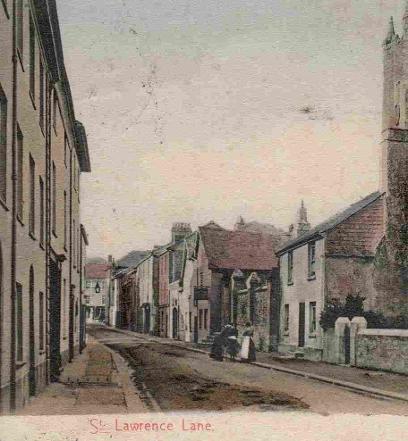
*Teetotaller
Many thanks to Hazel Bray for the above account
Left: Although coloured in, the above pre WW1 picture seems to show manure in the streets. See Hazel Bray's description above.
From my own collection